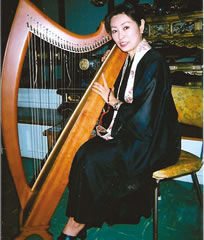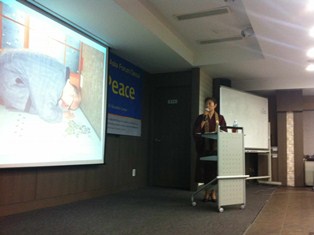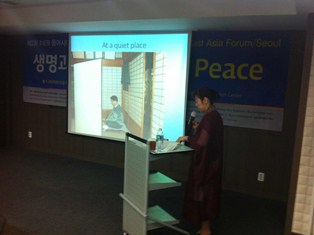Level II: Workshop #7 January 15, 2014
Introduction to Naikan:
Encountering Your Heart's Treasure
Rev. Mari Sengoku
Kokoro Research Center
Kyoto University
 The
Jodo Shin (True Pure Land) Buddhist tradition is not known to have a formal
practice like meditation, which is so central in Buddhism. This is because
of its emphasis on the absolute "other power" (tariki) of Amida
Buddha through which to experience salvation. However, if there is a particular
kind of Shin practice it might be found in the practice of Naikan, which literally
means "to look (kan) within (nai)" or self-introspection. Naikan
as a systematized method was developed by Rev. Ishin Yoshimoto (1916-1988),
a Jodo Shin priest, based on the practice of mishirabe by Jodo Shin Buddhist
followers in the rural areas around the ancient capital of Nara.
The
Jodo Shin (True Pure Land) Buddhist tradition is not known to have a formal
practice like meditation, which is so central in Buddhism. This is because
of its emphasis on the absolute "other power" (tariki) of Amida
Buddha through which to experience salvation. However, if there is a particular
kind of Shin practice it might be found in the practice of Naikan, which literally
means "to look (kan) within (nai)" or self-introspection. Naikan
as a systematized method was developed by Rev. Ishin Yoshimoto (1916-1988),
a Jodo Shin priest, based on the practice of mishirabe by Jodo Shin Buddhist
followers in the rural areas around the ancient capital of Nara.
In the practice of mishirabe, in addition to introspection, the practitioners fasted completely even without liquids, and went without sleep for long periods to reflect on their thoughts and behaviors. What Rev. Yoshimoto discovered through this practice was the degree to which his life had been sustained by others, by all living creatures, and ultimately by nature instead of only through self-centeredness and, by extension, ignorance. Based on his experience, Yoshimoto realized the possible use of this therapy for all people, not only Buddhist practitioners. So, he established a relatively easier method by eliminating the strict physical restrictions and formed three themes for "healthy" practitioners. Nowadays, the main goal of Naikan is not to achieve religious enlightenment, but to experience self-understanding and self-improvement, goals that can be applied to any person regardless of religion, ethnic group, or social background. (Sengoku 2010)
Naikan Practice
Naikan Therapy is often conducted as an intensive all day (6:00 a.m.- 9:00 p.m.) one week retreat, but can also be done as a daily practice for 30 minutes twice per day, morning and evening. The practice conditions for an intensive Naikan retreat are a quiet place, a comfortable seated position, and a 15-hour daily schedule of work devoted to self-examination on the Naikan themes. These themes are:
1. What have you received?
2. What have you given in return?
3. What troubles and difficulties have you caused?
These themes are explored in relation to the significant people in one's life, such as mother, father, spouses, children, and the people in the same workplace. One examines these relationships in chronological order from the time you were born, putting oneself in the shoes of others and trying to recollect concrete facts. During this time, one has no contact with media or with other people, only with the Naikan therapist. With such a vast amount of time for reflection, one can engage in such practices as doing a financial analysis of how much money one's parents spent on you for the first 18 years of one's life, covering all one's needs and also desires and presents.
The subsequent Naikan practitioner-therapist interview takes place at the client's Naikan practice room in a face to face interview that lasts three to five minutes every and occurs every one or two hours, eight to ten times a day. In reflecting on the three themes, there usually comes a recognition of past events and a reinterpretation and change of perspective toward one's relationships with other people. This leads to a more objective examination of things and an improved understanding of others as well as an experience of self-discovery and improved self-understanding.
In one case study, a 43-year-old female had Chronic Depressive Disorder and experienced depressive moods, poor appetite, sleep disorder, withdraw, diarrhea, and stomachaches. Over the first 3 days of Naikan therapy, she was passive with little self-reflection, but from the 5th though the 7th days, she began to examine herself more deeply. By the end of the week, she had become gentle with happier facial expression as well as appreciative and independent. Some months after this retreat, she was able to finish her treatment as an outpatient.
Another case study was of a 66-year old woman who was experiencing depression, loss of appetite, insomnia, and was taking medication for breathing difficulties. Her motive to practice Naikan was self-improvement and to gain confidence in caring for her elderly mother. Over the first 3 days, she remembered the happy aspects of her past. From the 4th to the 7th days, she concentrated on the love she had gotten from her grandmother that brought her happiness and also recalled with gratitude how her mother had cared for her. By the end of the week, she was able to give up the medicine she was taking for her breathing. In the months after the retreat, her mother died, but she felt grateful that she had done the retreat before seeing her mother off. Currently, she is living a satisfying life filled with gratitude.
In contrast to the intensive retreat, daily Naikan practice is done every morning and evening for 30 minutes. Intensive Naikan is practiced to learn how to practice in daily life. The most important thing is ultimately integrating Naikan into one's daily life continuously. In Daily Naikan, one begins with morning practice, looking at what is the meaning or significance of relationships with those around one and whether one has confronted one's true self in this process? After returning home at the end of the day and practicing Naikan again, one examines whether how much one had been subject to the flow of greed, jealousy, and anger? One also examines whether one has maintained an objective point of view and how much gratitude one has for one's surroundings?
Widespread Use of Naikan and Its Proven Efficacy
 Naikan has spread around the world and been developed in countries such
as the U.S., China, Thailand, Korea, and many countries in Europe such as
Germany, the Netherlands, Austria, Italy and Switzerland as well as Australia
and New Zealand. It has been used as a therapy in prisons, juvenile detention
centers, primary to secondary schools and universities, hospices, psychiatric
centers, drug and alcohol rehabilitation centers, and temples in order to
treat mental problems and disorders such as neurosis, addiction, depressive
disorders, maladjustment, eating disorders, school truancy, marital conflict,
and so forth. It has been used as a tool for self-reflection and self-improvement
for students, nurses, doctors, teachers, house makers, and businessmen.
Naikan has spread around the world and been developed in countries such
as the U.S., China, Thailand, Korea, and many countries in Europe such as
Germany, the Netherlands, Austria, Italy and Switzerland as well as Australia
and New Zealand. It has been used as a therapy in prisons, juvenile detention
centers, primary to secondary schools and universities, hospices, psychiatric
centers, drug and alcohol rehabilitation centers, and temples in order to
treat mental problems and disorders such as neurosis, addiction, depressive
disorders, maladjustment, eating disorders, school truancy, marital conflict,
and so forth. It has been used as a tool for self-reflection and self-improvement
for students, nurses, doctors, teachers, house makers, and businessmen.
A study on its effects with convicted criminals across four regions in Japan in 1965 showed a major reduction of two to eight times less for repeat offences for those who had undergone Naikan training. In another study in Japan in 2005, Naikan therapy was shown to be highly effective for the following disorders: alcoholism (over 40% highly effective), anxiety disorders (over 60% highly effective, 35% somewhat effective), depression (over 60% highly effective, over 35% somewhat effective), and neurological disorders (over 65% highly effective, 20% somewhat effective).
Further clinical research has also been performed examining whether daily Naikan therapy can maintain the efficacy of intensive Naikan therapy in dealing with depression. Between 2006 and 2008, forty-seven Japanese patients, who were diagnosed as having major depressive disorder and who practiced intensive Naikan therapy participated in a study. Two groups of patients were compared: 24 patients who conducted daily Naikan therapy and 23 patients who did not, after practicing intensive Naikan therapy. To evaluate efficacy, the Beck Depression Inventory was used as a primary outcome measure for the assessment of depression. The State?Trait Anxiety Inventory and the Cornell Medical Index were also used as secondary outcome measures to evaluate anxiety and psychosomatic conditions before, immediately after, and three months after intensive Naikan therapy.
The result was that significant between-group differences were obtained in the time course change of depression, anxiety, and psychosomatic scores within three months following the completion of intensive Naikan therapy. In conclusion, the study indicated that conducting daily Naikan therapy is effective for maintaining the psychological and psychosomatic state at 3 months following the intensive Naikan therapy, while a lack of therapy may allow the patients to exacerbate their conditions to the level they held before practicing intensive Naikan therapy. (Sengoku 2010)
From Psychological Care to Spiritual Transformation
 The core insights and emotional experiences of Naikan tend to be insights
into self-centeredness and the love of others; insights into problems or symptoms;
and emotional experiences involving: 1) guilt, remorse, forgiveness, 2) feelings
of being loved, gratefulness, and merging with others, 3) joy in discovering
oneself and others, and 4) inner peace through acceptance of oneself and others.
In sum, Naikan can have a transformative effect on practitioners turning a
self-centered and anxious view of life turn into one of gratitude and a peaceful
mind.
The core insights and emotional experiences of Naikan tend to be insights
into self-centeredness and the love of others; insights into problems or symptoms;
and emotional experiences involving: 1) guilt, remorse, forgiveness, 2) feelings
of being loved, gratefulness, and merging with others, 3) joy in discovering
oneself and others, and 4) inner peace through acceptance of oneself and others.
In sum, Naikan can have a transformative effect on practitioners turning a
self-centered and anxious view of life turn into one of gratitude and a peaceful
mind.
Naikan has also been used for spiritual care, especially for the dying with common experiences of oneness with the universe, a sense of being loved and embraced by the Buddha, an ability to live each day fully, and an acceptance of death and an eventual peaceful death. In one case study, a 76-year old male with Stage IVb esophageal cancer was experiencing both physical pain and the spiritual pain of the fear of death. Naikan was introduced in order to do a life review. He subsequently had a near death experience reminiscent of the song A Thousand Winds and developed an acceptance of death, ultimately experiencing a peaceful departure
A Thousand Winds
I am a thousand winds.
Don't stand at my grave and weep. I am not there,
I do not sleep. I am sunlight on ripened grain.
I am the gentle autumn rain.
I am a thousand winds. I am a thousand winds that blow.
I am diamond glint on snow, a thousand winds that blow.
Don't stand at my grave and cry. I am not there.
I did not die. I am the swift rush of birds in flight,
Kokoro Research Center
Soft stars that shine at night.
Conclusion of Workshop
After this presentation on Naikan therapy, Rev. Sengoku sang A Thousand Winds while playing a small harp, a musical performance she has offered many times in hospices as part of her healing work as a chaplain. She then led the group in a guided meditation/reflection on their early childhood from the day they were born until 3rd grade of primary school. The participants were then asked to reflect on the three themes of what they received, what they gave in return, and what trouble they caused in reference to their own mother. After a period of sharing, Rev. Sengoku reviewed 10 points for the continual practice of Naikan in daily life:
1) saying thanks 10 times
2) asking forgiveness 10 times
3) offering compliments 10 times
4) remembering 10 people who have helped you in accomplishing something
5) performing silent acts of help and support
6) cleaning up messy or dirty things
7) saying thanks to things used and thrown away
8) one day Naikan
Reference:
Mari Sengoku, Hiroaki Murata, Takanobu Kawahara, Kaori Imamura, and Kazuyuki Nakagome. "Does daily Naikan therapy maintain the efficacy of intensive Naikan therapy against depression?" Psychiatry and Clinical Neurosciences 2010; 64: 44-51.
Mari Sengoku. One Dies as One Lives: The Importance of Developing Pastoral Care Services and Religious Education. In Watts & Tomatsu Eds. Buddhist Care for the Dying and Bereaved. Boston: Wisdom Publications, 2012.

